Quality Management for Organisational Excellence: Case Study Analysis
VerifiedAdded on 2023/01/12
|11
|3607
|31
Report
AI Summary
This report provides an analysis of quality management principles and their application within an organisational context, specifically using Quality Tooling Company as a case study. The report delves into the concepts of total quality management (TQM), quality control, and quality assurance, highlighting their significance in achieving organisational excellence. It explores how TQM, with its customer focus, management commitment, employee empowerment, and continuous improvement principles, can be implemented using the PDCA cycle. Additionally, the report examines the importance of quality control techniques such as stratification, control charts, fishbone diagrams, and histograms, as well as quality assurance approaches including statistical control and adherence to standards like ISO 9000. The report concludes by emphasizing the role of these tools and techniques in improving product and service quality, enhancing customer satisfaction, and fostering a culture of continuous improvement within the organisation.

Quality management for
organisational excellence
organisational excellence
Paraphrase This Document
Need a fresh take? Get an instant paraphrase of this document with our AI Paraphraser
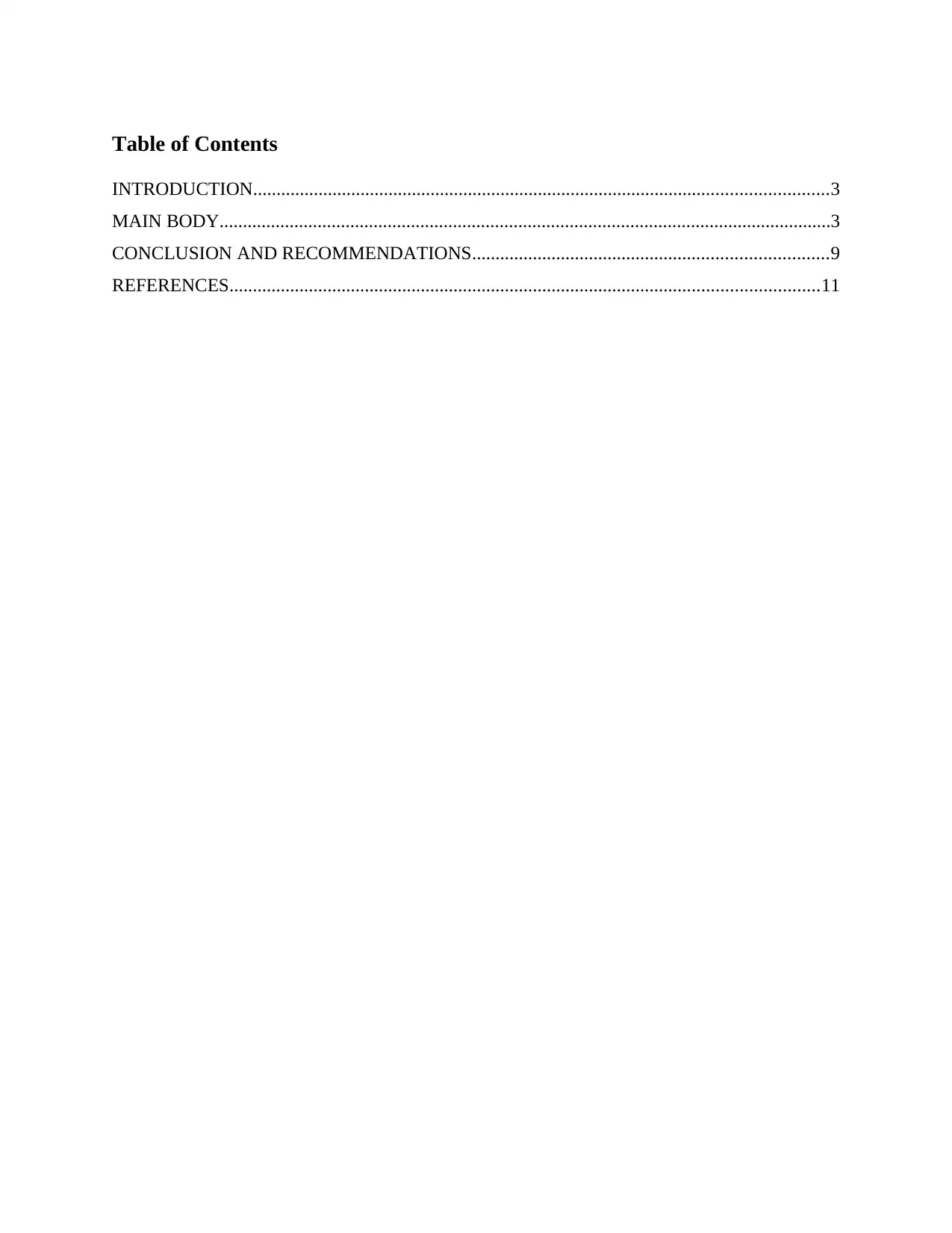
Table of Contents
INTRODUCTION...........................................................................................................................3
MAIN BODY...................................................................................................................................3
CONCLUSION AND RECOMMENDATIONS............................................................................9
REFERENCES..............................................................................................................................11
INTRODUCTION...........................................................................................................................3
MAIN BODY...................................................................................................................................3
CONCLUSION AND RECOMMENDATIONS............................................................................9
REFERENCES..............................................................................................................................11
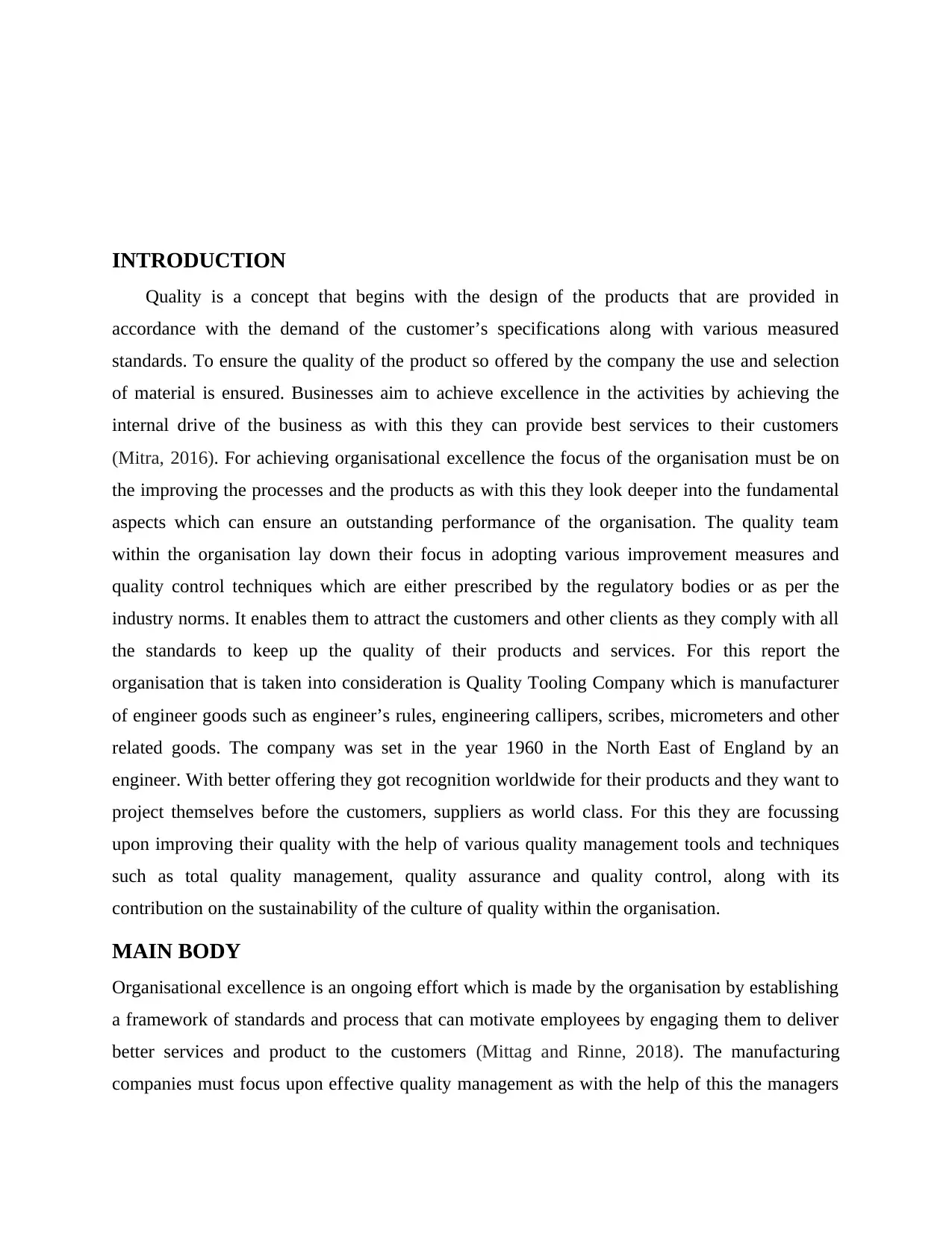
INTRODUCTION
Quality is a concept that begins with the design of the products that are provided in
accordance with the demand of the customer’s specifications along with various measured
standards. To ensure the quality of the product so offered by the company the use and selection
of material is ensured. Businesses aim to achieve excellence in the activities by achieving the
internal drive of the business as with this they can provide best services to their customers
(Mitra, 2016). For achieving organisational excellence the focus of the organisation must be on
the improving the processes and the products as with this they look deeper into the fundamental
aspects which can ensure an outstanding performance of the organisation. The quality team
within the organisation lay down their focus in adopting various improvement measures and
quality control techniques which are either prescribed by the regulatory bodies or as per the
industry norms. It enables them to attract the customers and other clients as they comply with all
the standards to keep up the quality of their products and services. For this report the
organisation that is taken into consideration is Quality Tooling Company which is manufacturer
of engineer goods such as engineer’s rules, engineering callipers, scribes, micrometers and other
related goods. The company was set in the year 1960 in the North East of England by an
engineer. With better offering they got recognition worldwide for their products and they want to
project themselves before the customers, suppliers as world class. For this they are focussing
upon improving their quality with the help of various quality management tools and techniques
such as total quality management, quality assurance and quality control, along with its
contribution on the sustainability of the culture of quality within the organisation.
MAIN BODY
Organisational excellence is an ongoing effort which is made by the organisation by establishing
a framework of standards and process that can motivate employees by engaging them to deliver
better services and product to the customers (Mittag and Rinne, 2018). The manufacturing
companies must focus upon effective quality management as with the help of this the managers
Quality is a concept that begins with the design of the products that are provided in
accordance with the demand of the customer’s specifications along with various measured
standards. To ensure the quality of the product so offered by the company the use and selection
of material is ensured. Businesses aim to achieve excellence in the activities by achieving the
internal drive of the business as with this they can provide best services to their customers
(Mitra, 2016). For achieving organisational excellence the focus of the organisation must be on
the improving the processes and the products as with this they look deeper into the fundamental
aspects which can ensure an outstanding performance of the organisation. The quality team
within the organisation lay down their focus in adopting various improvement measures and
quality control techniques which are either prescribed by the regulatory bodies or as per the
industry norms. It enables them to attract the customers and other clients as they comply with all
the standards to keep up the quality of their products and services. For this report the
organisation that is taken into consideration is Quality Tooling Company which is manufacturer
of engineer goods such as engineer’s rules, engineering callipers, scribes, micrometers and other
related goods. The company was set in the year 1960 in the North East of England by an
engineer. With better offering they got recognition worldwide for their products and they want to
project themselves before the customers, suppliers as world class. For this they are focussing
upon improving their quality with the help of various quality management tools and techniques
such as total quality management, quality assurance and quality control, along with its
contribution on the sustainability of the culture of quality within the organisation.
MAIN BODY
Organisational excellence is an ongoing effort which is made by the organisation by establishing
a framework of standards and process that can motivate employees by engaging them to deliver
better services and product to the customers (Mittag and Rinne, 2018). The manufacturing
companies must focus upon effective quality management as with the help of this the managers
⊘ This is a preview!⊘
Do you want full access?
Subscribe today to unlock all pages.

Trusted by 1+ million students worldwide
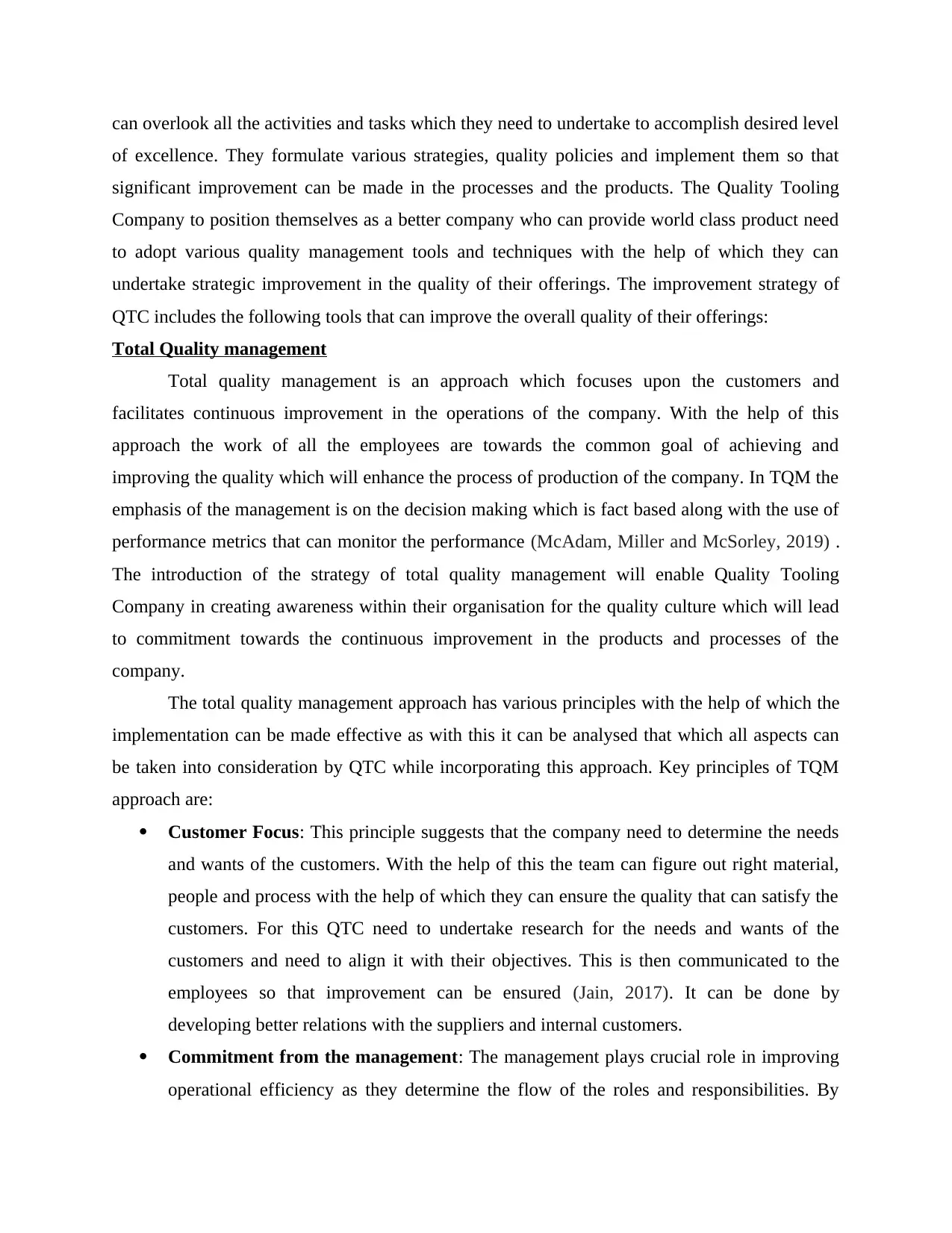
can overlook all the activities and tasks which they need to undertake to accomplish desired level
of excellence. They formulate various strategies, quality policies and implement them so that
significant improvement can be made in the processes and the products. The Quality Tooling
Company to position themselves as a better company who can provide world class product need
to adopt various quality management tools and techniques with the help of which they can
undertake strategic improvement in the quality of their offerings. The improvement strategy of
QTC includes the following tools that can improve the overall quality of their offerings:
Total Quality management
Total quality management is an approach which focuses upon the customers and
facilitates continuous improvement in the operations of the company. With the help of this
approach the work of all the employees are towards the common goal of achieving and
improving the quality which will enhance the process of production of the company. In TQM the
emphasis of the management is on the decision making which is fact based along with the use of
performance metrics that can monitor the performance (McAdam, Miller and McSorley, 2019) .
The introduction of the strategy of total quality management will enable Quality Tooling
Company in creating awareness within their organisation for the quality culture which will lead
to commitment towards the continuous improvement in the products and processes of the
company.
The total quality management approach has various principles with the help of which the
implementation can be made effective as with this it can be analysed that which all aspects can
be taken into consideration by QTC while incorporating this approach. Key principles of TQM
approach are:
Customer Focus: This principle suggests that the company need to determine the needs
and wants of the customers. With the help of this the team can figure out right material,
people and process with the help of which they can ensure the quality that can satisfy the
customers. For this QTC need to undertake research for the needs and wants of the
customers and need to align it with their objectives. This is then communicated to the
employees so that improvement can be ensured (Jain, 2017). It can be done by
developing better relations with the suppliers and internal customers.
Commitment from the management: The management plays crucial role in improving
operational efficiency as they determine the flow of the roles and responsibilities. By
of excellence. They formulate various strategies, quality policies and implement them so that
significant improvement can be made in the processes and the products. The Quality Tooling
Company to position themselves as a better company who can provide world class product need
to adopt various quality management tools and techniques with the help of which they can
undertake strategic improvement in the quality of their offerings. The improvement strategy of
QTC includes the following tools that can improve the overall quality of their offerings:
Total Quality management
Total quality management is an approach which focuses upon the customers and
facilitates continuous improvement in the operations of the company. With the help of this
approach the work of all the employees are towards the common goal of achieving and
improving the quality which will enhance the process of production of the company. In TQM the
emphasis of the management is on the decision making which is fact based along with the use of
performance metrics that can monitor the performance (McAdam, Miller and McSorley, 2019) .
The introduction of the strategy of total quality management will enable Quality Tooling
Company in creating awareness within their organisation for the quality culture which will lead
to commitment towards the continuous improvement in the products and processes of the
company.
The total quality management approach has various principles with the help of which the
implementation can be made effective as with this it can be analysed that which all aspects can
be taken into consideration by QTC while incorporating this approach. Key principles of TQM
approach are:
Customer Focus: This principle suggests that the company need to determine the needs
and wants of the customers. With the help of this the team can figure out right material,
people and process with the help of which they can ensure the quality that can satisfy the
customers. For this QTC need to undertake research for the needs and wants of the
customers and need to align it with their objectives. This is then communicated to the
employees so that improvement can be ensured (Jain, 2017). It can be done by
developing better relations with the suppliers and internal customers.
Commitment from the management: The management plays crucial role in improving
operational efficiency as they determine the flow of the roles and responsibilities. By
Paraphrase This Document
Need a fresh take? Get an instant paraphrase of this document with our AI Paraphraser
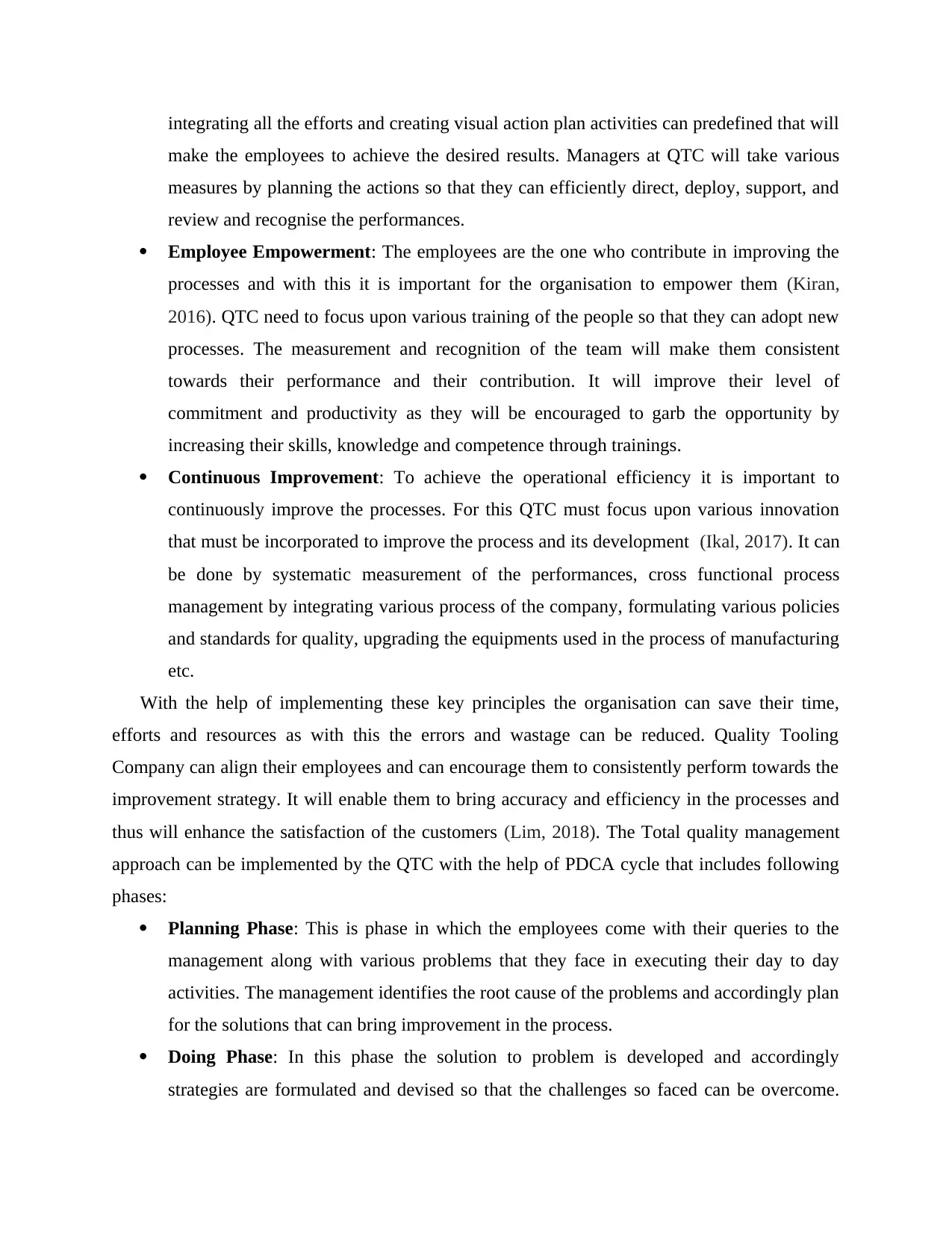
integrating all the efforts and creating visual action plan activities can predefined that will
make the employees to achieve the desired results. Managers at QTC will take various
measures by planning the actions so that they can efficiently direct, deploy, support, and
review and recognise the performances.
Employee Empowerment: The employees are the one who contribute in improving the
processes and with this it is important for the organisation to empower them (Kiran,
2016). QTC need to focus upon various training of the people so that they can adopt new
processes. The measurement and recognition of the team will make them consistent
towards their performance and their contribution. It will improve their level of
commitment and productivity as they will be encouraged to garb the opportunity by
increasing their skills, knowledge and competence through trainings.
Continuous Improvement: To achieve the operational efficiency it is important to
continuously improve the processes. For this QTC must focus upon various innovation
that must be incorporated to improve the process and its development (Ikal, 2017). It can
be done by systematic measurement of the performances, cross functional process
management by integrating various process of the company, formulating various policies
and standards for quality, upgrading the equipments used in the process of manufacturing
etc.
With the help of implementing these key principles the organisation can save their time,
efforts and resources as with this the errors and wastage can be reduced. Quality Tooling
Company can align their employees and can encourage them to consistently perform towards the
improvement strategy. It will enable them to bring accuracy and efficiency in the processes and
thus will enhance the satisfaction of the customers (Lim, 2018). The Total quality management
approach can be implemented by the QTC with the help of PDCA cycle that includes following
phases:
Planning Phase: This is phase in which the employees come with their queries to the
management along with various problems that they face in executing their day to day
activities. The management identifies the root cause of the problems and accordingly plan
for the solutions that can bring improvement in the process.
Doing Phase: In this phase the solution to problem is developed and accordingly
strategies are formulated and devised so that the challenges so faced can be overcome.
make the employees to achieve the desired results. Managers at QTC will take various
measures by planning the actions so that they can efficiently direct, deploy, support, and
review and recognise the performances.
Employee Empowerment: The employees are the one who contribute in improving the
processes and with this it is important for the organisation to empower them (Kiran,
2016). QTC need to focus upon various training of the people so that they can adopt new
processes. The measurement and recognition of the team will make them consistent
towards their performance and their contribution. It will improve their level of
commitment and productivity as they will be encouraged to garb the opportunity by
increasing their skills, knowledge and competence through trainings.
Continuous Improvement: To achieve the operational efficiency it is important to
continuously improve the processes. For this QTC must focus upon various innovation
that must be incorporated to improve the process and its development (Ikal, 2017). It can
be done by systematic measurement of the performances, cross functional process
management by integrating various process of the company, formulating various policies
and standards for quality, upgrading the equipments used in the process of manufacturing
etc.
With the help of implementing these key principles the organisation can save their time,
efforts and resources as with this the errors and wastage can be reduced. Quality Tooling
Company can align their employees and can encourage them to consistently perform towards the
improvement strategy. It will enable them to bring accuracy and efficiency in the processes and
thus will enhance the satisfaction of the customers (Lim, 2018). The Total quality management
approach can be implemented by the QTC with the help of PDCA cycle that includes following
phases:
Planning Phase: This is phase in which the employees come with their queries to the
management along with various problems that they face in executing their day to day
activities. The management identifies the root cause of the problems and accordingly plan
for the solutions that can bring improvement in the process.
Doing Phase: In this phase the solution to problem is developed and accordingly
strategies are formulated and devised so that the challenges so faced can be overcome.
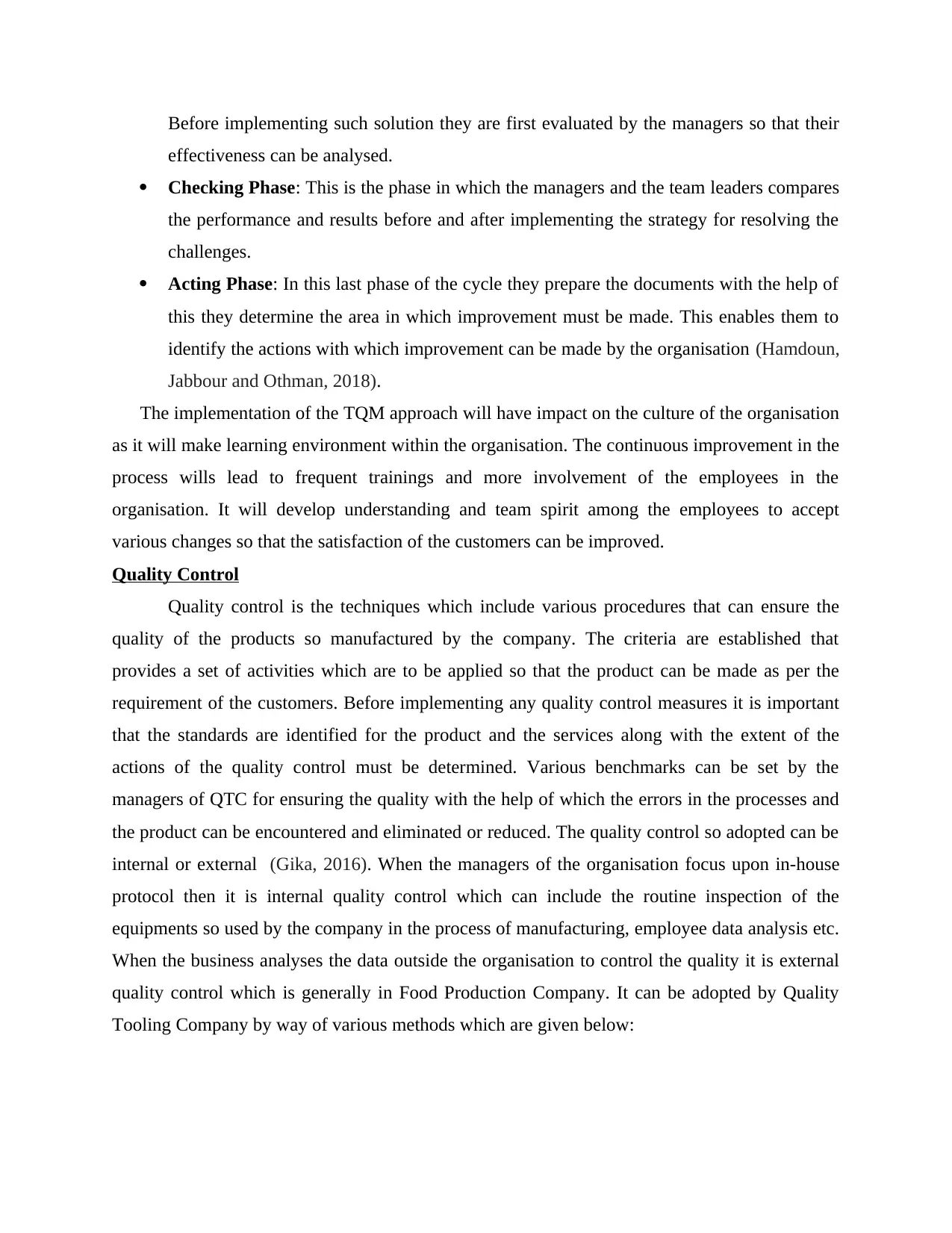
Before implementing such solution they are first evaluated by the managers so that their
effectiveness can be analysed.
Checking Phase: This is the phase in which the managers and the team leaders compares
the performance and results before and after implementing the strategy for resolving the
challenges.
Acting Phase: In this last phase of the cycle they prepare the documents with the help of
this they determine the area in which improvement must be made. This enables them to
identify the actions with which improvement can be made by the organisation (Hamdoun,
Jabbour and Othman, 2018).
The implementation of the TQM approach will have impact on the culture of the organisation
as it will make learning environment within the organisation. The continuous improvement in the
process wills lead to frequent trainings and more involvement of the employees in the
organisation. It will develop understanding and team spirit among the employees to accept
various changes so that the satisfaction of the customers can be improved.
Quality Control
Quality control is the techniques which include various procedures that can ensure the
quality of the products so manufactured by the company. The criteria are established that
provides a set of activities which are to be applied so that the product can be made as per the
requirement of the customers. Before implementing any quality control measures it is important
that the standards are identified for the product and the services along with the extent of the
actions of the quality control must be determined. Various benchmarks can be set by the
managers of QTC for ensuring the quality with the help of which the errors in the processes and
the product can be encountered and eliminated or reduced. The quality control so adopted can be
internal or external (Gika, 2016). When the managers of the organisation focus upon in-house
protocol then it is internal quality control which can include the routine inspection of the
equipments so used by the company in the process of manufacturing, employee data analysis etc.
When the business analyses the data outside the organisation to control the quality it is external
quality control which is generally in Food Production Company. It can be adopted by Quality
Tooling Company by way of various methods which are given below:
effectiveness can be analysed.
Checking Phase: This is the phase in which the managers and the team leaders compares
the performance and results before and after implementing the strategy for resolving the
challenges.
Acting Phase: In this last phase of the cycle they prepare the documents with the help of
this they determine the area in which improvement must be made. This enables them to
identify the actions with which improvement can be made by the organisation (Hamdoun,
Jabbour and Othman, 2018).
The implementation of the TQM approach will have impact on the culture of the organisation
as it will make learning environment within the organisation. The continuous improvement in the
process wills lead to frequent trainings and more involvement of the employees in the
organisation. It will develop understanding and team spirit among the employees to accept
various changes so that the satisfaction of the customers can be improved.
Quality Control
Quality control is the techniques which include various procedures that can ensure the
quality of the products so manufactured by the company. The criteria are established that
provides a set of activities which are to be applied so that the product can be made as per the
requirement of the customers. Before implementing any quality control measures it is important
that the standards are identified for the product and the services along with the extent of the
actions of the quality control must be determined. Various benchmarks can be set by the
managers of QTC for ensuring the quality with the help of which the errors in the processes and
the product can be encountered and eliminated or reduced. The quality control so adopted can be
internal or external (Gika, 2016). When the managers of the organisation focus upon in-house
protocol then it is internal quality control which can include the routine inspection of the
equipments so used by the company in the process of manufacturing, employee data analysis etc.
When the business analyses the data outside the organisation to control the quality it is external
quality control which is generally in Food Production Company. It can be adopted by Quality
Tooling Company by way of various methods which are given below:
⊘ This is a preview!⊘
Do you want full access?
Subscribe today to unlock all pages.

Trusted by 1+ million students worldwide
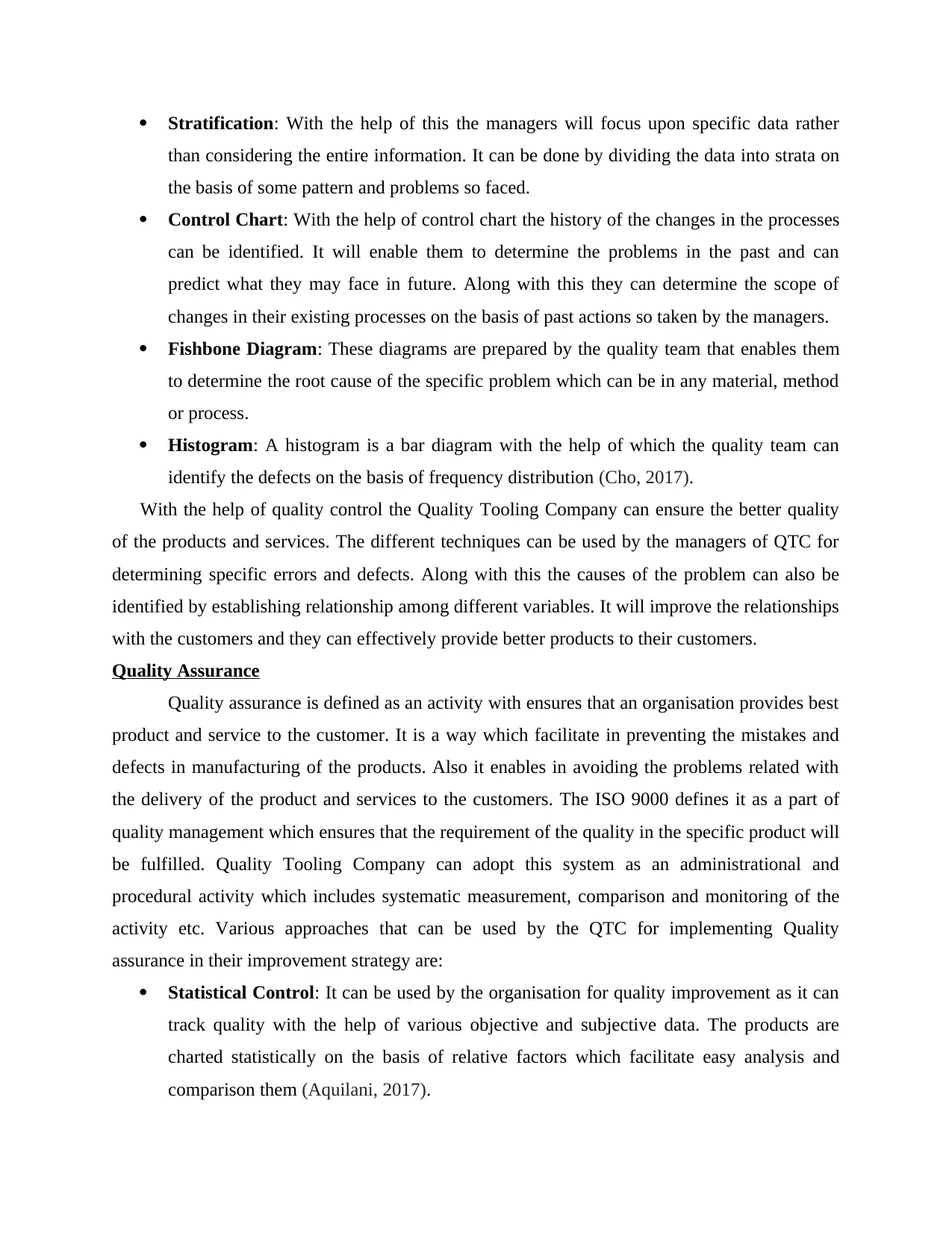
Stratification: With the help of this the managers will focus upon specific data rather
than considering the entire information. It can be done by dividing the data into strata on
the basis of some pattern and problems so faced.
Control Chart: With the help of control chart the history of the changes in the processes
can be identified. It will enable them to determine the problems in the past and can
predict what they may face in future. Along with this they can determine the scope of
changes in their existing processes on the basis of past actions so taken by the managers.
Fishbone Diagram: These diagrams are prepared by the quality team that enables them
to determine the root cause of the specific problem which can be in any material, method
or process.
Histogram: A histogram is a bar diagram with the help of which the quality team can
identify the defects on the basis of frequency distribution (Cho, 2017).
With the help of quality control the Quality Tooling Company can ensure the better quality
of the products and services. The different techniques can be used by the managers of QTC for
determining specific errors and defects. Along with this the causes of the problem can also be
identified by establishing relationship among different variables. It will improve the relationships
with the customers and they can effectively provide better products to their customers.
Quality Assurance
Quality assurance is defined as an activity with ensures that an organisation provides best
product and service to the customer. It is a way which facilitate in preventing the mistakes and
defects in manufacturing of the products. Also it enables in avoiding the problems related with
the delivery of the product and services to the customers. The ISO 9000 defines it as a part of
quality management which ensures that the requirement of the quality in the specific product will
be fulfilled. Quality Tooling Company can adopt this system as an administrational and
procedural activity which includes systematic measurement, comparison and monitoring of the
activity etc. Various approaches that can be used by the QTC for implementing Quality
assurance in their improvement strategy are:
Statistical Control: It can be used by the organisation for quality improvement as it can
track quality with the help of various objective and subjective data. The products are
charted statistically on the basis of relative factors which facilitate easy analysis and
comparison them (Aquilani, 2017).
than considering the entire information. It can be done by dividing the data into strata on
the basis of some pattern and problems so faced.
Control Chart: With the help of control chart the history of the changes in the processes
can be identified. It will enable them to determine the problems in the past and can
predict what they may face in future. Along with this they can determine the scope of
changes in their existing processes on the basis of past actions so taken by the managers.
Fishbone Diagram: These diagrams are prepared by the quality team that enables them
to determine the root cause of the specific problem which can be in any material, method
or process.
Histogram: A histogram is a bar diagram with the help of which the quality team can
identify the defects on the basis of frequency distribution (Cho, 2017).
With the help of quality control the Quality Tooling Company can ensure the better quality
of the products and services. The different techniques can be used by the managers of QTC for
determining specific errors and defects. Along with this the causes of the problem can also be
identified by establishing relationship among different variables. It will improve the relationships
with the customers and they can effectively provide better products to their customers.
Quality Assurance
Quality assurance is defined as an activity with ensures that an organisation provides best
product and service to the customer. It is a way which facilitate in preventing the mistakes and
defects in manufacturing of the products. Also it enables in avoiding the problems related with
the delivery of the product and services to the customers. The ISO 9000 defines it as a part of
quality management which ensures that the requirement of the quality in the specific product will
be fulfilled. Quality Tooling Company can adopt this system as an administrational and
procedural activity which includes systematic measurement, comparison and monitoring of the
activity etc. Various approaches that can be used by the QTC for implementing Quality
assurance in their improvement strategy are:
Statistical Control: It can be used by the organisation for quality improvement as it can
track quality with the help of various objective and subjective data. The products are
charted statistically on the basis of relative factors which facilitate easy analysis and
comparison them (Aquilani, 2017).
Paraphrase This Document
Need a fresh take? Get an instant paraphrase of this document with our AI Paraphraser
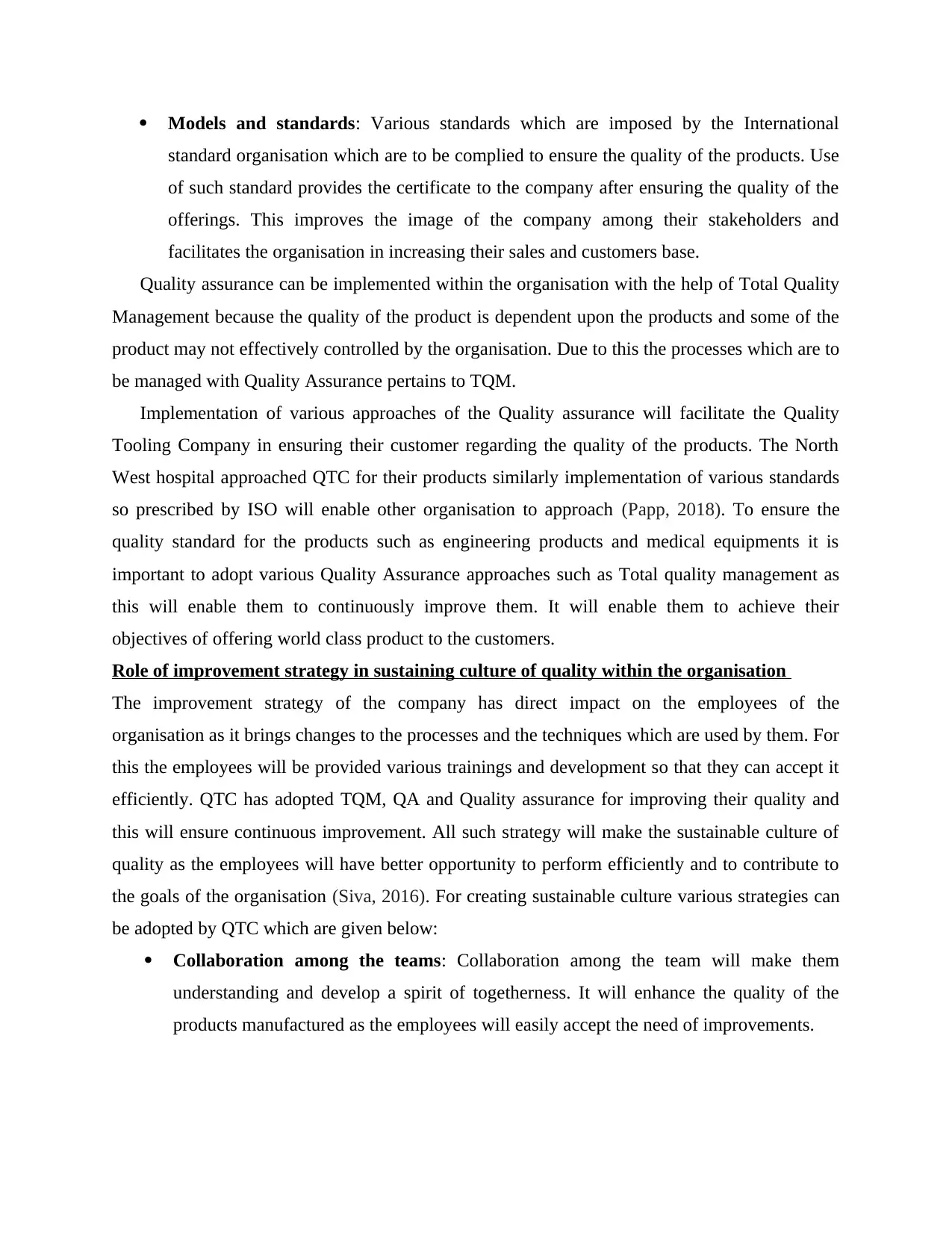
Models and standards: Various standards which are imposed by the International
standard organisation which are to be complied to ensure the quality of the products. Use
of such standard provides the certificate to the company after ensuring the quality of the
offerings. This improves the image of the company among their stakeholders and
facilitates the organisation in increasing their sales and customers base.
Quality assurance can be implemented within the organisation with the help of Total Quality
Management because the quality of the product is dependent upon the products and some of the
product may not effectively controlled by the organisation. Due to this the processes which are to
be managed with Quality Assurance pertains to TQM.
Implementation of various approaches of the Quality assurance will facilitate the Quality
Tooling Company in ensuring their customer regarding the quality of the products. The North
West hospital approached QTC for their products similarly implementation of various standards
so prescribed by ISO will enable other organisation to approach (Papp, 2018). To ensure the
quality standard for the products such as engineering products and medical equipments it is
important to adopt various Quality Assurance approaches such as Total quality management as
this will enable them to continuously improve them. It will enable them to achieve their
objectives of offering world class product to the customers.
Role of improvement strategy in sustaining culture of quality within the organisation
The improvement strategy of the company has direct impact on the employees of the
organisation as it brings changes to the processes and the techniques which are used by them. For
this the employees will be provided various trainings and development so that they can accept it
efficiently. QTC has adopted TQM, QA and Quality assurance for improving their quality and
this will ensure continuous improvement. All such strategy will make the sustainable culture of
quality as the employees will have better opportunity to perform efficiently and to contribute to
the goals of the organisation (Siva, 2016). For creating sustainable culture various strategies can
be adopted by QTC which are given below:
Collaboration among the teams: Collaboration among the team will make them
understanding and develop a spirit of togetherness. It will enhance the quality of the
products manufactured as the employees will easily accept the need of improvements.
standard organisation which are to be complied to ensure the quality of the products. Use
of such standard provides the certificate to the company after ensuring the quality of the
offerings. This improves the image of the company among their stakeholders and
facilitates the organisation in increasing their sales and customers base.
Quality assurance can be implemented within the organisation with the help of Total Quality
Management because the quality of the product is dependent upon the products and some of the
product may not effectively controlled by the organisation. Due to this the processes which are to
be managed with Quality Assurance pertains to TQM.
Implementation of various approaches of the Quality assurance will facilitate the Quality
Tooling Company in ensuring their customer regarding the quality of the products. The North
West hospital approached QTC for their products similarly implementation of various standards
so prescribed by ISO will enable other organisation to approach (Papp, 2018). To ensure the
quality standard for the products such as engineering products and medical equipments it is
important to adopt various Quality Assurance approaches such as Total quality management as
this will enable them to continuously improve them. It will enable them to achieve their
objectives of offering world class product to the customers.
Role of improvement strategy in sustaining culture of quality within the organisation
The improvement strategy of the company has direct impact on the employees of the
organisation as it brings changes to the processes and the techniques which are used by them. For
this the employees will be provided various trainings and development so that they can accept it
efficiently. QTC has adopted TQM, QA and Quality assurance for improving their quality and
this will ensure continuous improvement. All such strategy will make the sustainable culture of
quality as the employees will have better opportunity to perform efficiently and to contribute to
the goals of the organisation (Siva, 2016). For creating sustainable culture various strategies can
be adopted by QTC which are given below:
Collaboration among the teams: Collaboration among the team will make them
understanding and develop a spirit of togetherness. It will enhance the quality of the
products manufactured as the employees will easily accept the need of improvements.
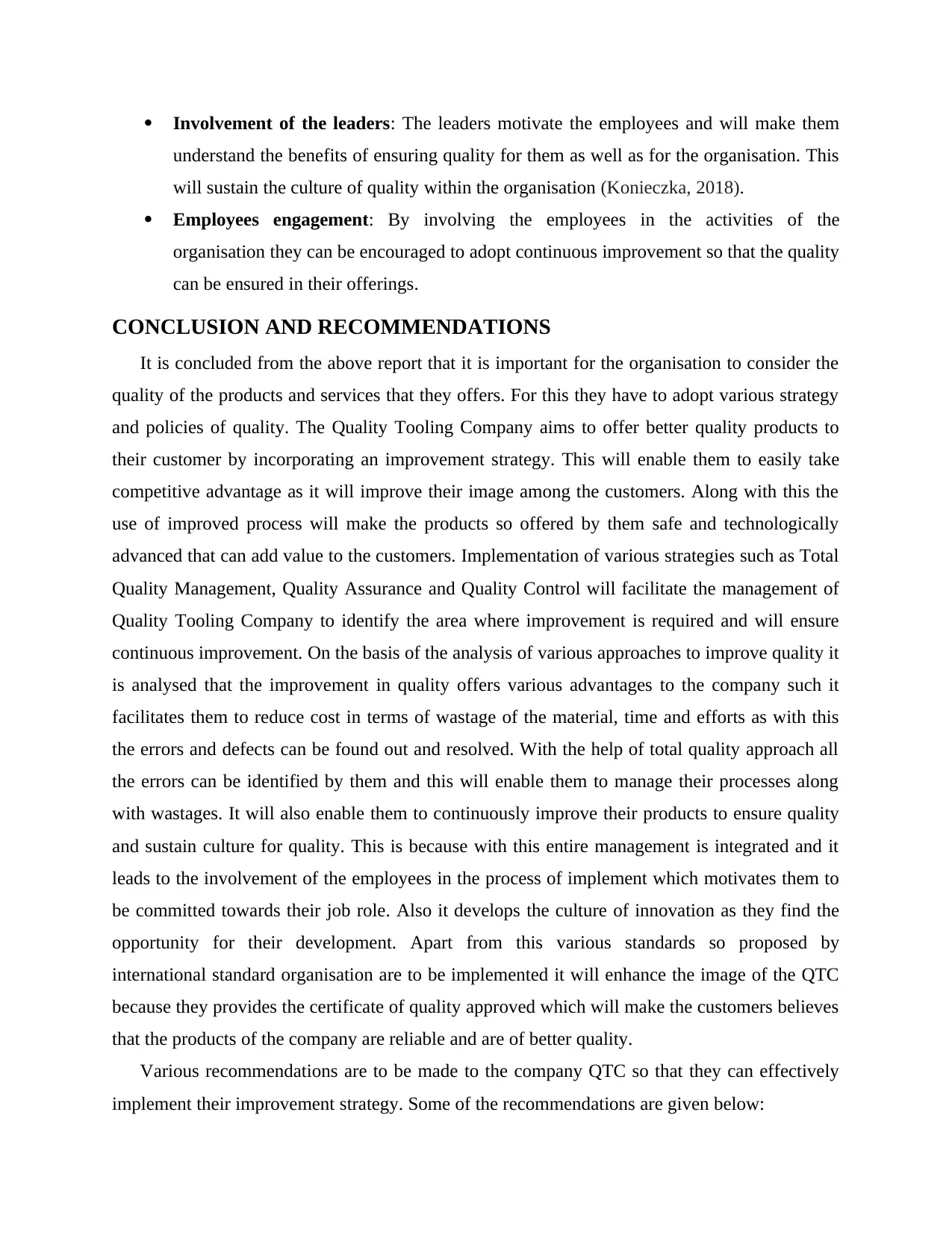
Involvement of the leaders: The leaders motivate the employees and will make them
understand the benefits of ensuring quality for them as well as for the organisation. This
will sustain the culture of quality within the organisation (Konieczka, 2018).
Employees engagement: By involving the employees in the activities of the
organisation they can be encouraged to adopt continuous improvement so that the quality
can be ensured in their offerings.
CONCLUSION AND RECOMMENDATIONS
It is concluded from the above report that it is important for the organisation to consider the
quality of the products and services that they offers. For this they have to adopt various strategy
and policies of quality. The Quality Tooling Company aims to offer better quality products to
their customer by incorporating an improvement strategy. This will enable them to easily take
competitive advantage as it will improve their image among the customers. Along with this the
use of improved process will make the products so offered by them safe and technologically
advanced that can add value to the customers. Implementation of various strategies such as Total
Quality Management, Quality Assurance and Quality Control will facilitate the management of
Quality Tooling Company to identify the area where improvement is required and will ensure
continuous improvement. On the basis of the analysis of various approaches to improve quality it
is analysed that the improvement in quality offers various advantages to the company such it
facilitates them to reduce cost in terms of wastage of the material, time and efforts as with this
the errors and defects can be found out and resolved. With the help of total quality approach all
the errors can be identified by them and this will enable them to manage their processes along
with wastages. It will also enable them to continuously improve their products to ensure quality
and sustain culture for quality. This is because with this entire management is integrated and it
leads to the involvement of the employees in the process of implement which motivates them to
be committed towards their job role. Also it develops the culture of innovation as they find the
opportunity for their development. Apart from this various standards so proposed by
international standard organisation are to be implemented it will enhance the image of the QTC
because they provides the certificate of quality approved which will make the customers believes
that the products of the company are reliable and are of better quality.
Various recommendations are to be made to the company QTC so that they can effectively
implement their improvement strategy. Some of the recommendations are given below:
understand the benefits of ensuring quality for them as well as for the organisation. This
will sustain the culture of quality within the organisation (Konieczka, 2018).
Employees engagement: By involving the employees in the activities of the
organisation they can be encouraged to adopt continuous improvement so that the quality
can be ensured in their offerings.
CONCLUSION AND RECOMMENDATIONS
It is concluded from the above report that it is important for the organisation to consider the
quality of the products and services that they offers. For this they have to adopt various strategy
and policies of quality. The Quality Tooling Company aims to offer better quality products to
their customer by incorporating an improvement strategy. This will enable them to easily take
competitive advantage as it will improve their image among the customers. Along with this the
use of improved process will make the products so offered by them safe and technologically
advanced that can add value to the customers. Implementation of various strategies such as Total
Quality Management, Quality Assurance and Quality Control will facilitate the management of
Quality Tooling Company to identify the area where improvement is required and will ensure
continuous improvement. On the basis of the analysis of various approaches to improve quality it
is analysed that the improvement in quality offers various advantages to the company such it
facilitates them to reduce cost in terms of wastage of the material, time and efforts as with this
the errors and defects can be found out and resolved. With the help of total quality approach all
the errors can be identified by them and this will enable them to manage their processes along
with wastages. It will also enable them to continuously improve their products to ensure quality
and sustain culture for quality. This is because with this entire management is integrated and it
leads to the involvement of the employees in the process of implement which motivates them to
be committed towards their job role. Also it develops the culture of innovation as they find the
opportunity for their development. Apart from this various standards so proposed by
international standard organisation are to be implemented it will enhance the image of the QTC
because they provides the certificate of quality approved which will make the customers believes
that the products of the company are reliable and are of better quality.
Various recommendations are to be made to the company QTC so that they can effectively
implement their improvement strategy. Some of the recommendations are given below:
⊘ This is a preview!⊘
Do you want full access?
Subscribe today to unlock all pages.

Trusted by 1+ million students worldwide
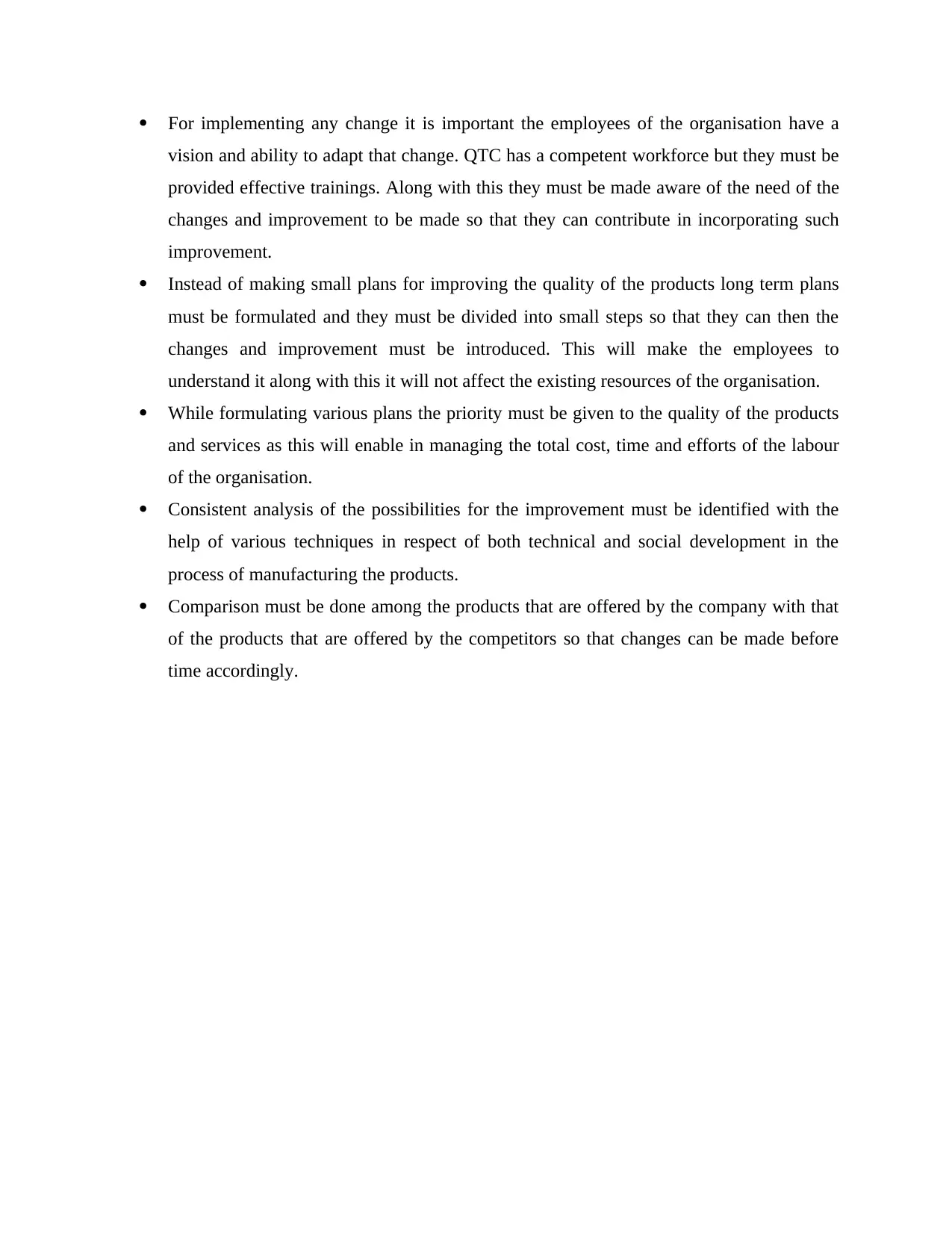
For implementing any change it is important the employees of the organisation have a
vision and ability to adapt that change. QTC has a competent workforce but they must be
provided effective trainings. Along with this they must be made aware of the need of the
changes and improvement to be made so that they can contribute in incorporating such
improvement.
Instead of making small plans for improving the quality of the products long term plans
must be formulated and they must be divided into small steps so that they can then the
changes and improvement must be introduced. This will make the employees to
understand it along with this it will not affect the existing resources of the organisation.
While formulating various plans the priority must be given to the quality of the products
and services as this will enable in managing the total cost, time and efforts of the labour
of the organisation.
Consistent analysis of the possibilities for the improvement must be identified with the
help of various techniques in respect of both technical and social development in the
process of manufacturing the products.
Comparison must be done among the products that are offered by the company with that
of the products that are offered by the competitors so that changes can be made before
time accordingly.
vision and ability to adapt that change. QTC has a competent workforce but they must be
provided effective trainings. Along with this they must be made aware of the need of the
changes and improvement to be made so that they can contribute in incorporating such
improvement.
Instead of making small plans for improving the quality of the products long term plans
must be formulated and they must be divided into small steps so that they can then the
changes and improvement must be introduced. This will make the employees to
understand it along with this it will not affect the existing resources of the organisation.
While formulating various plans the priority must be given to the quality of the products
and services as this will enable in managing the total cost, time and efforts of the labour
of the organisation.
Consistent analysis of the possibilities for the improvement must be identified with the
help of various techniques in respect of both technical and social development in the
process of manufacturing the products.
Comparison must be done among the products that are offered by the company with that
of the products that are offered by the competitors so that changes can be made before
time accordingly.
Paraphrase This Document
Need a fresh take? Get an instant paraphrase of this document with our AI Paraphraser
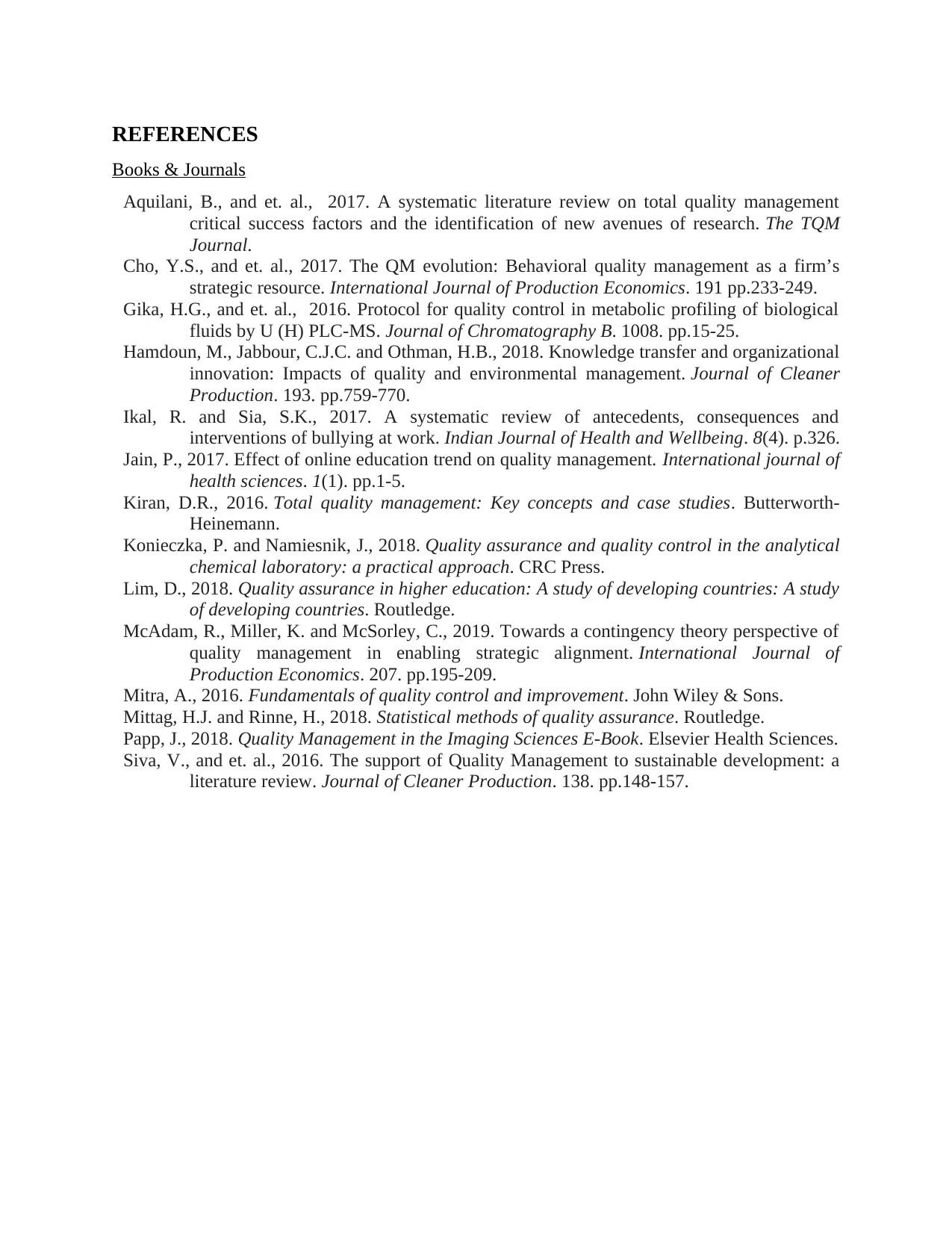
REFERENCES
Books & Journals
Aquilani, B., and et. al., 2017. A systematic literature review on total quality management
critical success factors and the identification of new avenues of research. The TQM
Journal.
Cho, Y.S., and et. al., 2017. The QM evolution: Behavioral quality management as a firm’s
strategic resource. International Journal of Production Economics. 191 pp.233-249.
Gika, H.G., and et. al., 2016. Protocol for quality control in metabolic profiling of biological
fluids by U (H) PLC-MS. Journal of Chromatography B. 1008. pp.15-25.
Hamdoun, M., Jabbour, C.J.C. and Othman, H.B., 2018. Knowledge transfer and organizational
innovation: Impacts of quality and environmental management. Journal of Cleaner
Production. 193. pp.759-770.
Ikal, R. and Sia, S.K., 2017. A systematic review of antecedents, consequences and
interventions of bullying at work. Indian Journal of Health and Wellbeing. 8(4). p.326.
Jain, P., 2017. Effect of online education trend on quality management. International journal of
health sciences. 1(1). pp.1-5.
Kiran, D.R., 2016. Total quality management: Key concepts and case studies. Butterworth-
Heinemann.
Konieczka, P. and Namiesnik, J., 2018. Quality assurance and quality control in the analytical
chemical laboratory: a practical approach. CRC Press.
Lim, D., 2018. Quality assurance in higher education: A study of developing countries: A study
of developing countries. Routledge.
McAdam, R., Miller, K. and McSorley, C., 2019. Towards a contingency theory perspective of
quality management in enabling strategic alignment. International Journal of
Production Economics. 207. pp.195-209.
Mitra, A., 2016. Fundamentals of quality control and improvement. John Wiley & Sons.
Mittag, H.J. and Rinne, H., 2018. Statistical methods of quality assurance. Routledge.
Papp, J., 2018. Quality Management in the Imaging Sciences E-Book. Elsevier Health Sciences.
Siva, V., and et. al., 2016. The support of Quality Management to sustainable development: a
literature review. Journal of Cleaner Production. 138. pp.148-157.
Books & Journals
Aquilani, B., and et. al., 2017. A systematic literature review on total quality management
critical success factors and the identification of new avenues of research. The TQM
Journal.
Cho, Y.S., and et. al., 2017. The QM evolution: Behavioral quality management as a firm’s
strategic resource. International Journal of Production Economics. 191 pp.233-249.
Gika, H.G., and et. al., 2016. Protocol for quality control in metabolic profiling of biological
fluids by U (H) PLC-MS. Journal of Chromatography B. 1008. pp.15-25.
Hamdoun, M., Jabbour, C.J.C. and Othman, H.B., 2018. Knowledge transfer and organizational
innovation: Impacts of quality and environmental management. Journal of Cleaner
Production. 193. pp.759-770.
Ikal, R. and Sia, S.K., 2017. A systematic review of antecedents, consequences and
interventions of bullying at work. Indian Journal of Health and Wellbeing. 8(4). p.326.
Jain, P., 2017. Effect of online education trend on quality management. International journal of
health sciences. 1(1). pp.1-5.
Kiran, D.R., 2016. Total quality management: Key concepts and case studies. Butterworth-
Heinemann.
Konieczka, P. and Namiesnik, J., 2018. Quality assurance and quality control in the analytical
chemical laboratory: a practical approach. CRC Press.
Lim, D., 2018. Quality assurance in higher education: A study of developing countries: A study
of developing countries. Routledge.
McAdam, R., Miller, K. and McSorley, C., 2019. Towards a contingency theory perspective of
quality management in enabling strategic alignment. International Journal of
Production Economics. 207. pp.195-209.
Mitra, A., 2016. Fundamentals of quality control and improvement. John Wiley & Sons.
Mittag, H.J. and Rinne, H., 2018. Statistical methods of quality assurance. Routledge.
Papp, J., 2018. Quality Management in the Imaging Sciences E-Book. Elsevier Health Sciences.
Siva, V., and et. al., 2016. The support of Quality Management to sustainable development: a
literature review. Journal of Cleaner Production. 138. pp.148-157.
1 out of 11
Related Documents
Your All-in-One AI-Powered Toolkit for Academic Success.
+13062052269
info@desklib.com
Available 24*7 on WhatsApp / Email
![[object Object]](/_next/static/media/star-bottom.7253800d.svg)
Unlock your academic potential
Copyright © 2020–2025 A2Z Services. All Rights Reserved. Developed and managed by ZUCOL.




